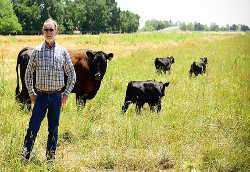By Pat Bailey

Affter more than 50 years of research, the tick-borne bacterium responsible for one of the most troubling and economically devastating cattle diseases in the Western United States has been named and genetically characterized by researchers at the University of California, Davis.
“This is a most unusual bug, a ‘Ripley’s Believe It or Not’ bacterium, and the tick that carries it is equally bizarre,” said veterinary immunologist Jeffrey Stott, who has led the effort to develop a preventive vaccine for the malady that western ranchers know all too well as “foothill abortion disease.”
Using an electron microscope, Stott and colleagues physically examined the bacterium in tissue sections taken during postmortem exams of aborted calves. They then characterized it by partially sequencing three of its genes and named it “Pajaroellobacter abortibovis,” recognizing the Pajaroello tick that carries the bacterium as well as its abortion-inducing impact on infected cows and their fetuses.
The findings of this study are reported in the Aug. 30 issue of the journal Veterinary Microbiology, now available through ScienceDirect.
The disease, which occurs in California’s coastal mountains and the foothill regions of California, Southern Oregon and Northern Nevada, annually results in the death of an estimated 45,000 to 90,000 unborn calves.
Vaccine trials to prevent the disease are now in the second year, thanks to a longtime partnership between UC Davis, the University of Nevada, Reno, and the California Cattlemen’s Association. During the first year, some 9,000 heifers throughout California were inoculated with the live vaccine several months before they become pregnant.
Ranchers’ foothill nemesis
Ranchers in California and neighboring states have struggled with foothill abortion disease at least as far back as the 1940s. While the disease seemed to have little impact on the health of the pregnant cows grazing in the foothills, it resulted in their calves being aborted, stillborn or born so weak that they soon died.
In the 1980s, UC Davis School of Veterinary Medicine researchers found evidence that the infected cow fetuses were producing an immune response to an unidentified microbe. Between 2000 and 2010, Stott and colleagues identified the microbe as a member of the genus Myxococcus and developed techniques to grow the live bacteria in laboratory mice. Cells from such mice were eventually used to develop the vaccine.
Slow-growing bacteria resist culturing
“This bacterium is like no other animal pathogen ever described,” Stott said. “It probably replicates only once per day, which explains why we were unable to cultivate it using standard laboratory techniques.”
He noted that the bacterium also has a much smaller genome than the most closely related, characterized bacterium, indicating that Pajaroellobacter abortibovis has probably lost some of its genetic material as it evolved.
Not your everyday tick
The Pajaroello tick is as intriguing as the disease-causing bacteria it carries, Stott said. Unlike more common ticks that burrow their way into the skin of people and animals to feed, the Pajaroello is a soft-bodied tick and does not embed itself in its hosts.
Instead, the Pajaroello lives in the decomposing plant litter at the base of trees, shrubs and rocks, and is attracted to cattle by the carbon dioxide the animals give off. Only once every few months, the tick makes the effort to pierce the cow’s skin and feed on its blood for about 20 minutes.
Native peoples of the U.S. reportedly feared the bite of the Pajaroello more than the bite of rattlesnakes, believing that a second bite by the tick would be fatal to a person. Cows, on the other hand, can have a local response to tick bites but appear to have minimal systemic reaction.
“If the bacteria that cause foothill abortion are transmitted to cows by a tick bite or experimental injection, they don’t cause an inflammatory response — probably in part because the bacteria replicate so slowly,” Stott said.
Unfortunately, cows’ developing fetuses are not so lucky.
Deadly to fetuses
“It turns out that once the bacteria get into the cow’s tissue, they travel to the cow’s uterus,” Stott said. “In cows and other ruminants, no antibodies are passed between the mother and the fetus, so the fetus is immunologically naive and thus very vulnerable.”
As the fetus matures, it begins to develop an immune system, eventually triggering an immunological response to the presence of the bacteria.
“The fetus essentially destroys itself and usually dies about four months after the cow is infected,” Stott said.
By that time, the rancher has lost the productive use of the cow for the season as well as the potential market value of the calf, which might be as much as $2,000 in today’s market.
Provides model of maternal-fetal interaction
The current vaccine appears to be more than 95 percent effective in preventing the infection in pregnant cows and their fetuses and may provide lifetime immunity for the vaccinated cows.
“From an efficacy standpoint this is the crème de la crème,” Stott said.
He hopes that further studies of the bacteria’s disease-causing mechanisms will provide a valuable model for studying the biology of maternal-fetal interactions and for developing an even better, second-generation vaccine against foothill abortion disease.